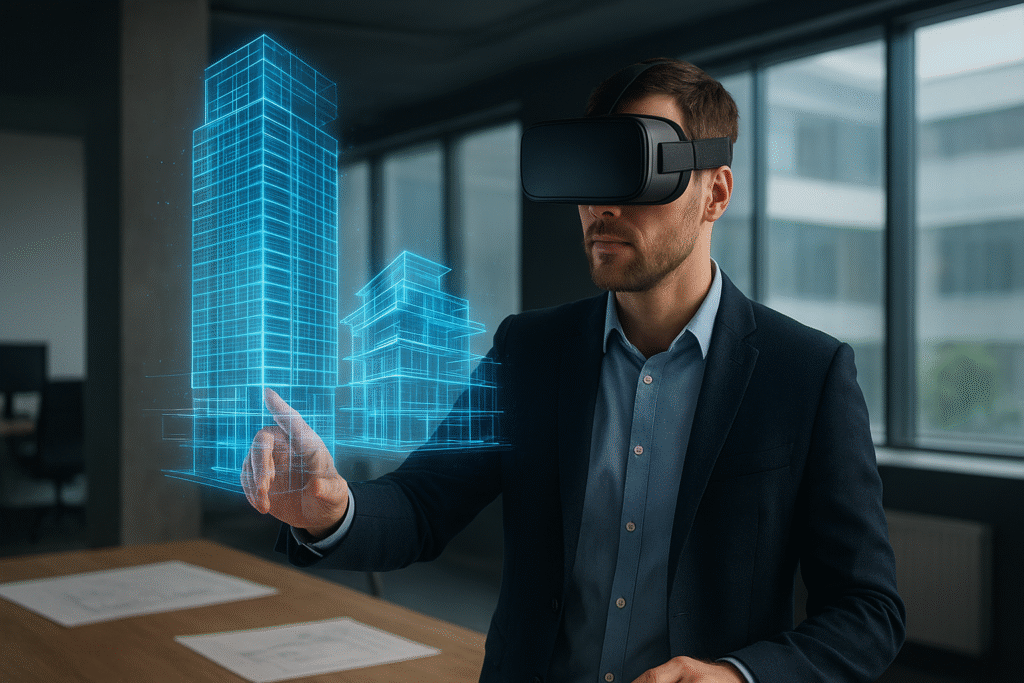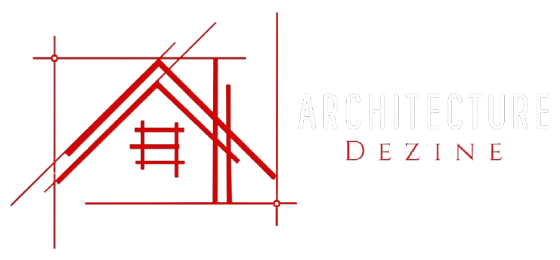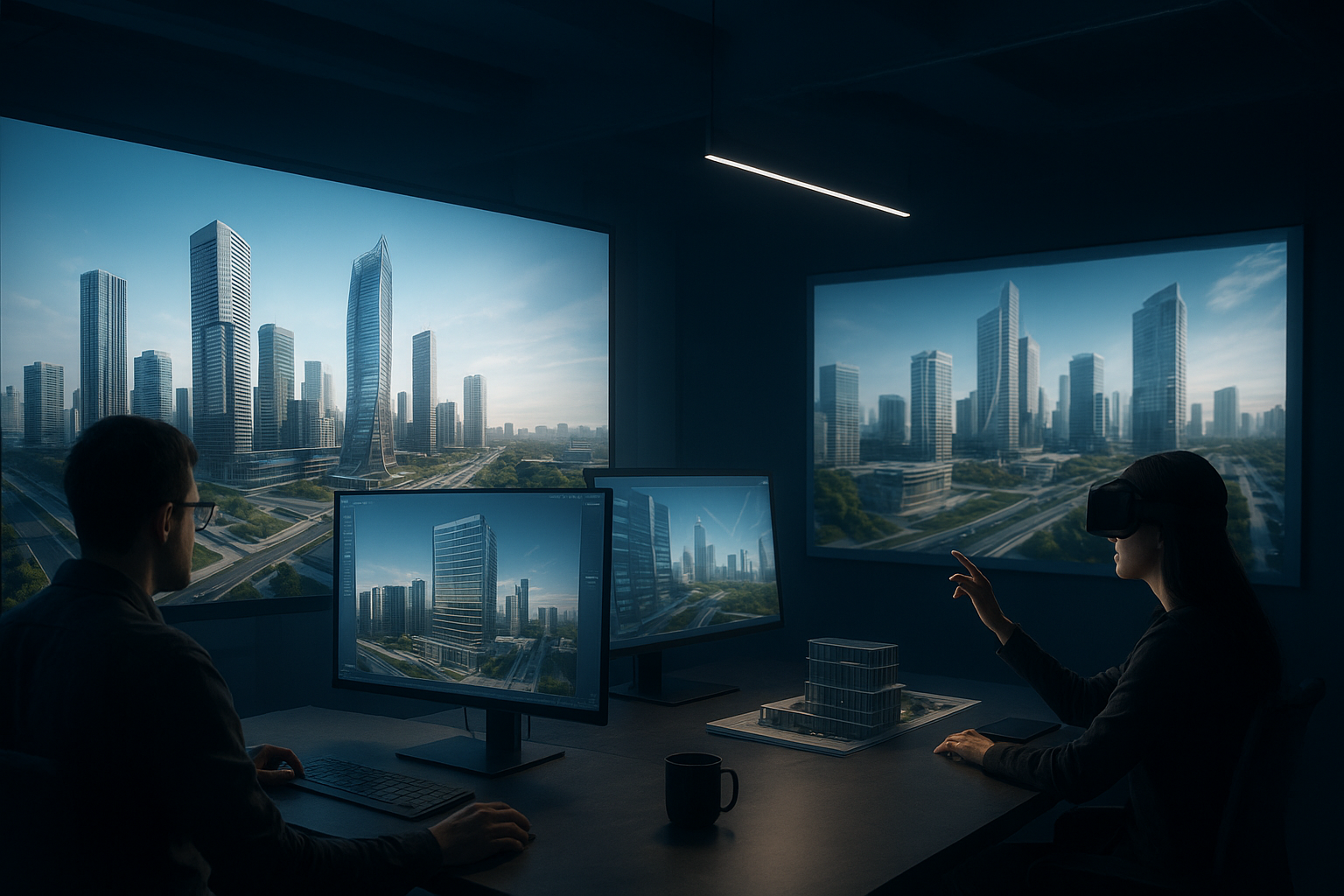3D Visualization in Architecture is transforming how we imagine, design, and construct buildings. In the modern world, architecture is no longer limited to blueprints and sketches. 3D visualization brings creativity, precision, and realism together to turn ideas into life-like spaces
Moreover, 3D visualization is the most revolutionary advancement in architecture, engineering, and construction (AEC). It’s more than a beautiful image — it’s the new language of modern design. This change completely transforms how architects communicate, think, and build.
This technology is more than just a means of producing stunning images; it is a paradigm shift. It transforms an architect’s vision into a nearly photorealistic reality with unparalleled clarity, inventiveness, and precision.
What is 3D Architectural Visualization?
The core of 3D architectural visualization is producing lifelike images, animations, and virtual reality (VR) experiences of a building before actual construction begins.
It uses powerful rendering engines like V-Ray and Lumion to process raw data from design software like Revit and SketchUp. These tools simulate real-world physics including lighting, textures, shadows, and spatial relationships.
As a result, this process provides a tangible, emotional, and spatial understanding of the finished structure for all stakeholders, including the architect, client, and builder.

3D Visualization in Architecture: Sharpening Design Communication
However, traditional blueprints and flat drawings often fail to convey spatial experiences. The largest issue in architecture has always been communication. How can you depict the effect of sunlight hitting a specific wall or the feeling of walking into a double-height foyer using only flat drawings?
Therefore, 3D renders are very effective in bridging that gap.
For clients seeking architectural design services, 3D visualization is a necessity rather than a luxury. According to general data, about 90% of clients prefer 3D renders before giving their final approval. Elevation plans no longer require them to squint in order to see their future home or place of business.
- Emotional Bond: Thanks to photorealistic imagery, clients can develop an emotional connection with the design by seeing their furniture, favorite materials, and the surrounding area accurately depicted.
- Clarity and Confidence: By replacing abstract lines with definitive scenes, the process gives clients total confidence in the design before they commit to a multi-million dollar construction budget.
Our expertise in producing these high-fidelity visualizations at Architecture Dezine helps us connect your vision with our structural knowledge.

Smarter, Faster Decision-Making and Revision
The speed and accuracy of 3D modeling greatly improves the design iteration process. Consequently, time and money are greatly reduced by this feature.
In the traditional workflow, a major flaw might go undetected until the building stage. Thus, with 3D visualization, problems are found and digitally resolved. This often leads to expensive teardowns and delays.
Identifying and Resolving Flaws
Modern software allows architects to perform complex analyses:
- Solar Studies: analyzing how light and shadows fall throughout the day and year to best position windows for comfort and energy efficiency.
- Spatial Conflicts: spotting potential structural, mechanical, or plumbing problems with walls before they become on-site disasters.
- Material Selection: Visual impact testing of different materials (marble, wood, steel) in real time without requiring the ordering of physical samples.

This ability to iterate quickly has a direct impact on time and cost efficiency. By making precise, fast adjustments in the digital world, architects can avoid costly on-site rework and guarantee that the project stays on budget and schedule.
How 3D Visualization Helps Architects Attract Visionary Clients
For architecture firms, 3D visualization is a powerful competitive differentiator. It turns a company’s portfolio from documentation into an aspirational story.
In today’s visually-driven market, a client’s decision is often influenced by a stunning 3D presentation. For instance, realistic renders attract more clients because they speak to the universal language of experience.
- Portfolio Power: A portfolio full of superb, photorealistic renders displays both built and unbuilt projects. It demonstrates a firm’s mastery of design and detail.
- Investment Confidence: When investors see a fully realized 3D model, they see less risk and more potential for success, which streamlines the funding process for major developments.
For our industry, the saying “Visualization is the language of modern architecture” has been adapted. It’s how businesses like Architecture Dezine attract forward-thinking partners and communicate excellence. Click here to check out the portfolio.

The Seamless Integration with Emerging Technology
The visualization revolution is not happening in isolation; the rapid development of related technologies drives it forward that promise even more immersive experiences.
- Virtual Reality (VR):Clients can virtually “walk through” their future building using virtual reality headsets, which offer a true spatial awareness experience and a 1:1 scale experience. It is the most effective method for winning over clients.
- Augmented Reality (AR):Using augmented reality applications, architects can overlay a digital model of a site on a tablet or phone to show how the proposed structure will integrate with the surroundings.
- Artificial Intelligence (AI):As AI begins to automate the tedious aspects of rendering, the architect can now focus solely on creativity, allowing for the quicker generation of environmental details, material textures, and even early design options.
This integration ensures that the visualization pipeline remains at the forefront by consistently enhancing design speed and accuracy.

For more reading on this synergy, see this article on the application of 3D technology in sustainable design. see this article on the application of 3D technology in sustainable design.
The Future of 3D Visualization in Modern Architecture
Looking ahead, 3D visualization will only grow in significance. In the future, 3D visualization will only grow in significance. It is rapidly evolving from an optional tool to a fundamental requirement for any serious architectural practice.
The future of the field lies in the digital twin, a real-time, highly detailed virtual model of a building that is used for continuous facility management, maintenance, and modification throughout the building’s lifecycle.
3D visualization is the first step toward this future. It creates the accurate, data-rich model that drives the entire design and construction ecosystem, paving the way for unprecedented levels of innovation in smart cities and sustainable infrastructure.

Conclusion: Bridging Imagination and Reality
In conclusion, 3D visualization has delivered on its promise to revolutionize architecture. 3D visualization has delivered on its promise to revolutionize architecture. What bridges the seemingly vast gap between pure creativity and practical construction is the essential technology.
It allows architects to dream bigger and has the resources to execute those dreams with flawless precision. Its promotion of a more transparent and collaborative process leads to better-designed buildings, more satisfied customers, and an overall more efficient industry.
3D visualization is Architecture Dezine’s primary area of expertise. We believe that by providing you with a clear vision of the future, we empower you to shape it. Our Services



